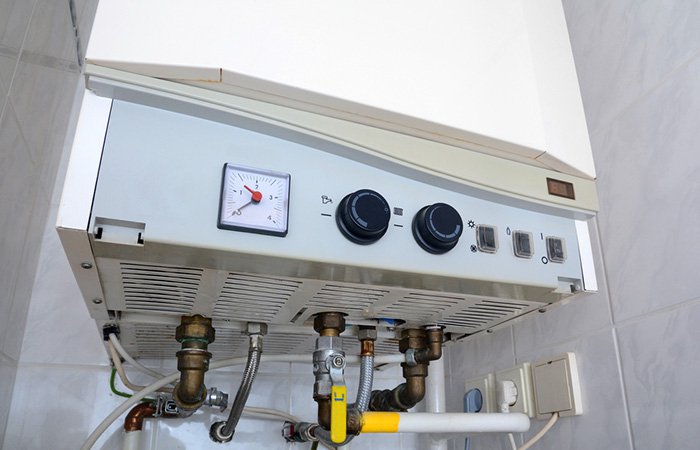For many years, atmospheric boilers were the most commonly used boiler types for heating in the domestic and commercial sectors. These boilers have now practically become extinct with the arrival of watertight and condensing boilers. However, the final blow for atmospheric boilers has been the new Spanish and European regulations that prohibit the manufacturing of these products and their use in new heating installations (for reasons of user safety and the urgency to reduce polluting emissions). With these new regulations in mind, this article will take a look at how atmospheric boilers work in comparison to other, more advanced technology and why they are not as efficient in terms of fuel and sustainability.
What is an atmospheric boiler?
Every boiler needs to incorporate air in order to carry out the combustion process. Atmospheric boilers take in air for combustion directly from the place in which they are located (unlike more modern boiler designs which take air in from the outside of the building through a tube).
This means that the atmospheric boiler’s location must have good ventilation. In addition, atmospheric boilers are not very efficient when it comes to burning fuel, making it a serious drawback in terms of environmental pollution and household budgeting. On top of this, an atmospheric boiler’s combustion chamber is not isolated from the room and this can expose the home’s residents to toxic fumes.
Atmospheric boilers: not allowed by law
Due to the above-mentioned drawbacks of atmospheric boilers, the new regulations stipulate that they cannot be used for domestic purposes. This came into effect on January 1, 2010 (although the law did issue a moratorium of several years to allow a gradual transition of the old to new technology) and their manufacturing has been prohibited since 2015.

These kinds of boilers can no longer be installed in family spaces, whether it is a new building or one that is being renovated. If a household owns an atmospheric boiler that they have used before the new regulations, they don’t need to change it. However, replacing it is recommended. For new boiler installations, sealed, condensing or very low NOx boilers should be used.
Atmospheric boilers: new regulations
We will now take a look at what the new Spanish regulations (Regulation of Thermal Installations in Buildings, known by its acronym, R.I.T.E.) and European regulations (ErP Directive and ELD Directive) say about atmospheric boilers. It states that they are now strictly prohibited for domestic use. They can only be used in boiler rooms with a special gas extraction device.
According to this extract from the R.I.T.E.: “The installation of atmospheric boilers is prohibited as of January 1, 2010”. Considering how humans are impacting the environment, condensing boilers should be used instead as their fuel efficiency always exceeds 100% and they are able to reduce polluting emissions by no less than 70%.

Atmospheric boilers vs. Watertight boilers
Performance or fuel-efficiency is a boiler’s inherent ability to convert fuel into heat. The higher the percentage, the higher the efficiency and the lower the polluting power. The percentage of fuel that is not burned enters the atmosphere in a polluting way. The economic savings is due to the boiler using less fuel to generate the same amount of heat. The boiler’s safety or toxicity is closely linked to the design of its air inlet and flue gas outlet. Bearing all of this in mind, we can now make a brief comparison between atmospheric boilers and watertight boilers.
Fuel Efficiency
Atmospheric boiler: Between 70 and 90% (the exact percentage varies depending on the brand and model).
Watertight boiler: More than 105% (the exact percentage varies depending on the make and model).
Economic savings
Atmospheric boiler: No savings. It is actually the opposite: atmospheric boilers waste fuel. Between 10 to 30% of the fuel you pay for is not burned or used by the boiler, and it is furthermore emitted into the environment in a polluting way.
Watertight boiler: Generally speaking, this type of boiler exceeds 100% in fuel efficiency. This is especially true if the boiler is a condensing boiler since its design ensures that heat is recycled to generate additional heat and hot water. This is more than what other kinds of boilers generate using the same amount of fuel.

Safety or toxicity
Atmospheric boiler: The combustion chamber is not isolated from the place where the unit is located, which poses a toxicity risk for users. Gases can be emitted directly into the room, and this can be dangerous if you do not have a gas extraction system.
Watertight boiler: The boiler’s combustion chamber is completely isolated from the premises (which is the definition of a watertight boiler) so it is considered the safest kind of boiler for users. Combustion gases never come into contact with people.
Air inlet and smoke outlet

Atmospheric boiler: The combusted air is taken directly from the room and the residual combustion fumes must exit spontaneously, which is risky.
Watertight boiler: The boiler is connected to the outside of the building only by pipes that bring in air and expel the fumes by means of a turbine that forces the gases to move.

